The road to Nakivale has gotten particularly bad over the last several weeks. We decided to capture some of it on video while traveling today. Hope you enjoy this little glimpse!
Some thoughts from the author…
A few weeks ago I saw a video going around on Facebook, in which a woman demonstrated how to make cream cheese.
The cheese she was actually making was either ricotta or queso (depending on how stringy it turned out). I don’t know how many times I’ve made ricotta cheese using the exact method she described. It’s simple. It’s quick. I’ve used it for lasagne and for any recipe that calls for cottage cheese.
But it’s not cream cheese.
Technically, to make cream cheese (or any cheese for that matter, with the exception of ricotta and mozzarella) you need a specific culture to get it going. “Culture”=bacteria that grows in the cheese and hardens it.
Yogurt is also cultured. Again, it’s not the same culture as cream cheese but it’s much closer than the method used by the woman in the video.
How to Make Cream Cheese
1. Make or buy yogurt.

As I posted on my blog a few days ago, yogurt making is quite simple.
2. Strain the yogurt until it’s thick.
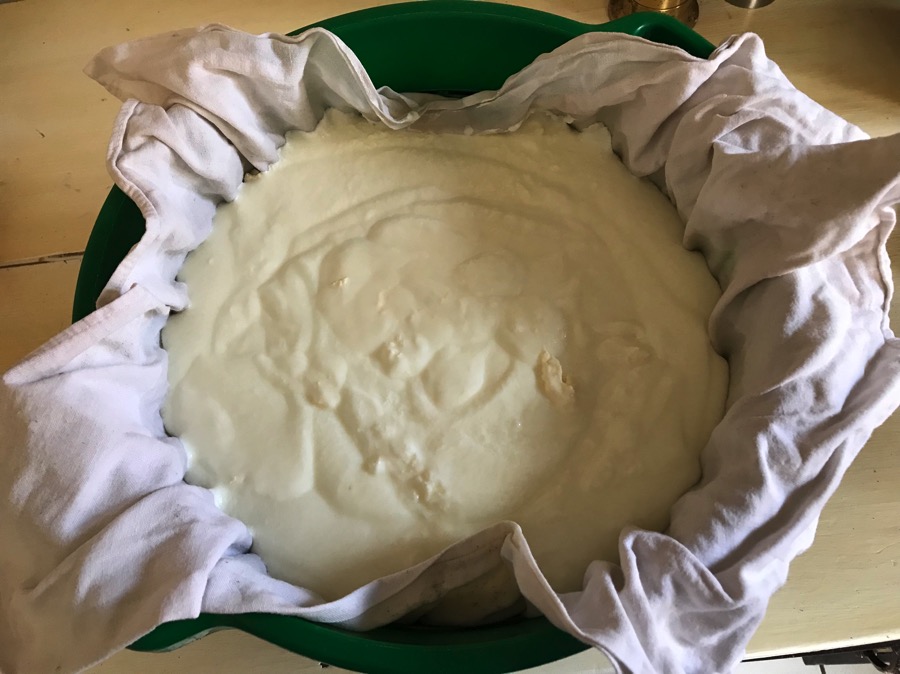
I put mine through a tea towel lining my strainer. Basically, I dump the yogurt into the tea-towel-lined strainer, suspend that in a pot to catch the whey, and stick it in the fridge.
And forget about it for a couple days.
That’s it.
It produces a by-product called “whey” which you can use for many things (in place of water in bread for higher protein content; we save it when we want to cure a corned beef because it acts like a meat tenderizer), or just pour it down the drain.
The finished product looks and tastes like cream cheese.

I’ve used it to make cheesecakes, to spread on toast, or for any recipe that calls for cream cheese.
Here is one of our favorite cream cheese recipes. It calls for several of the milk by-products we make: butter, yogurt/sour cream, and cream cheese. I hope you try it and enjoy it as much as we have!

Creamy Fruit Preserve Coffee Cake
- 2-1/4 cups flour
- 3/4 cup sugar
- 3/4 cup cold butter (I soften it to room temperature)
- 3/4 cup sour cream (I use plain yogurt)
- 1/2 teaspoon baking powder
- 1/2 teaspoon baking soda
- 1 egg
- 1 teaspoon almond extract (I use vanilla extract.)
In a mixing bowl, combine the flour and sugar; cut in butter until mixture resembles coarse crumbs. Set aside 1 cup for topping. To the remaining crumb mixture, add the remaining ingredients. Press into the bottom and 2 inches up the side of a 9 inch spring form pan. (I use a 9×13 baking dish.)
Filling:
- 8 oz. cream cheese softened
- 1/4 cup sugar
- 1 egg
- 3/4 cup fruit preserves (peach, cherry, apple, blueberry, strawberry)
- 1/2 cup sliced almonds (optional)
Combine the cream cheese, sugar, and egg. Spoon over prepared crust. Spread the preserves evenly over this. Top with almonds (optional) and reserved crumbs.
Bake at 350 degrees for 45-50 minutes or until filling is set and crust is golden brown. If using springform pan, cool for 15 minutes and then remove the side of the pan. Cool completely before serving.
We celebrated Easter Sunday with Sangano. They’ve been getting a good amount of rain the last few weeks (which is good) but it’s made the road a mess. We crept down the road at about 30-40km/hour (less than 25 mph) and still felt like we were going too fast. We reached one section of the road that was a pond. Thankfully, there was a way around the outside of it AND our 4-wheel drive works.
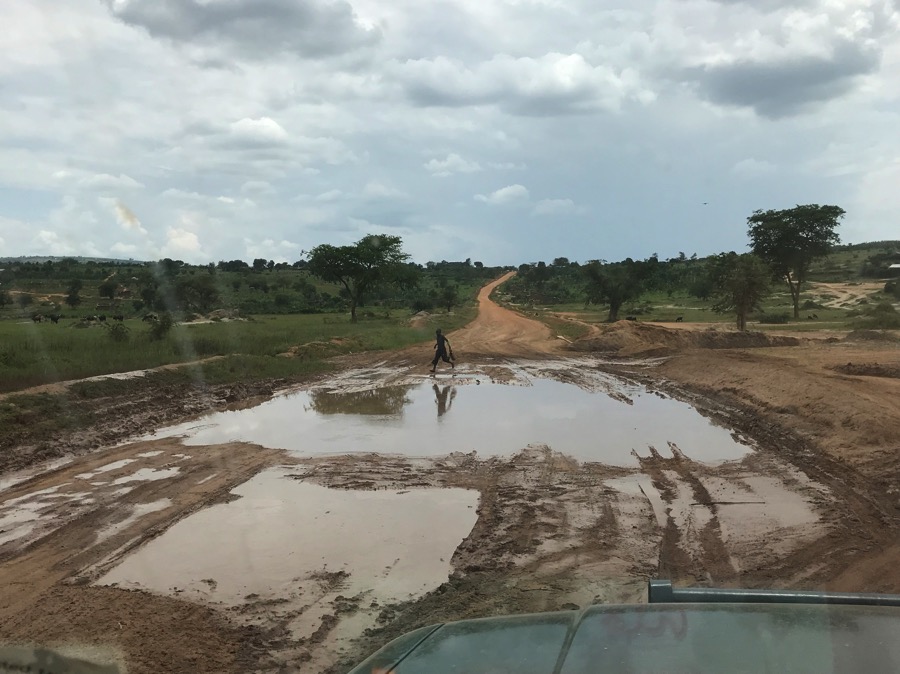
11 people were baptized this morning. What better way to celebrate our risen Lord than to picture being raised to new life in Christ. We started the service earlier than usual and one of the young men who wanted to be baptized hadn’t arrived yet. He came running in as everyone was finding their seats inside the church. James climbed back in the baptistry and baptized him before we continued with the service.
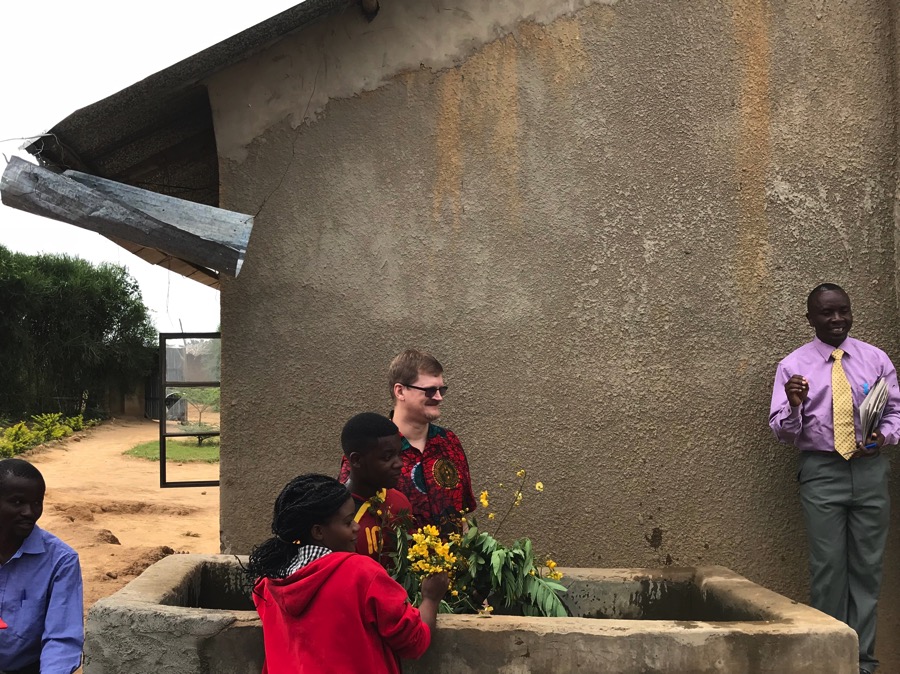
Finally, we showed the Jesus movie at Sangano. The church was packed and more and more people came in until all the seats were taken. The children filled in the rows at the front. When the movie finished, James gave an invitation and several people raised their hands. We’ll be following up with these people (most of them children!) in the next few weeks.

One of the ladies at church had a difficult pregnancy. She gave birth to the baby, a little boy, about 6 weeks ago. Today was her first day back at church with him and we got to meet him for the first time. I think Brennah fell in love. He slept while she held him for most of the church service.

And there’s just a little glimpse into our Easter in Uganda.
It’s super easy to make homemade yogurt. There’s no better way to get this cultured staple preservative-free than to make it yourself.
I started making yogurt before we ever came to Africa. We were able to get milk from a local farm. I’d found directions for making yogurt in a book I read and decided to try it out with the fresh milk. It turned out the first time!
Yogurt making is now a normal part of our weekly ritual. It takes time, but not much supervision. Most of the process is just letting the bacteria do its work to change the milk to yogurt. You don’t need any special equipment.
You’ll need:
- a pan with a lid in which to heat the milk and leave the yogurt until it has cultured
- a wooden spoon
- plain yogurt to use for a starter
- a towel (optional)
- flavoring (optional – see below)
How to Make Homemade Yogurt in 5 Easy Steps
1. Boil the milk.

It doesn’t need a hard boil, but it won’t hurt if it boils hard. You know what they say about watched pots. I can watch it simmer but not boil for 10 minutes, then leave or turn my back for one second and the milk boils over. *sigh*
This is the first place the wooden spoon comes in handy. If you lay the spoon on top of the milk, it breaks the surface tension and the milk tends not to boil over as easily.
2. Cool the milk until you can hold a finger in it for 10 seconds or longer.

If your milk is too hot, it will kill the culture on the yogurt starter. The milk is cool enough when you can hold your finger in it for several seconds. The cooling part takes longer than the boiling part. I come back and stir it on a regular basis (use the wooden spoon for this) and only test it when I can touch the outside of the pan without it burning me.
3. Add yogurt starter to the milk and mix thoroughly.

6-8oz. of plain yogurt is enough for a starter – in other words, it’s enough to start the culturing process. Once you’ve added the starter, mix it into the milk until it’s smooth and there are no chunks.
4. Cover and let it set for 6-12 hours.
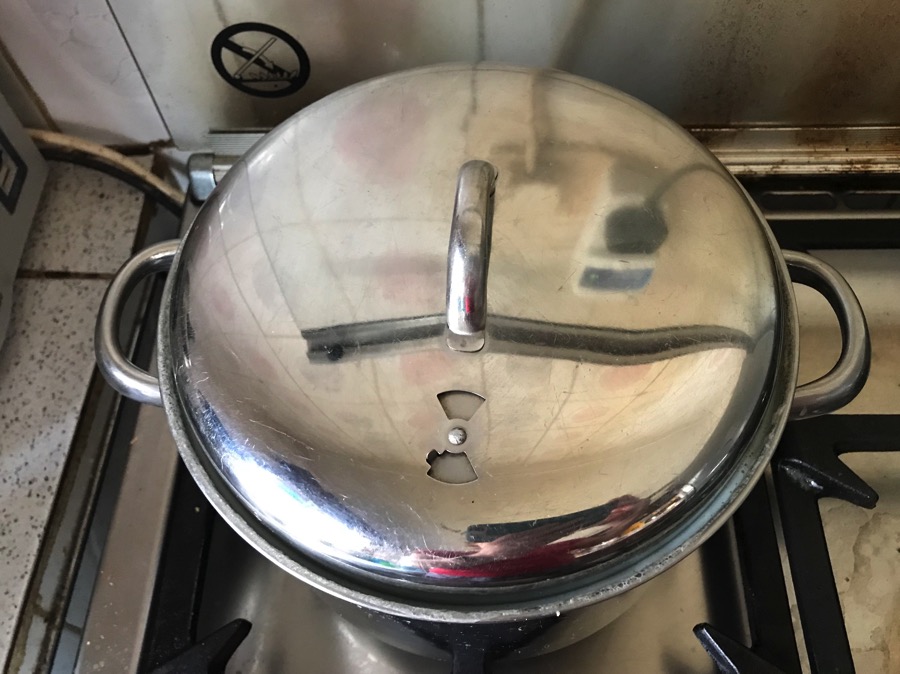
I leave mine sitting on the back of the stove but my kitchen stays around 80 degrees during the day. If your kitchen is cooler, place the pan with the yogurt inside the oven (oven turned off). This helps it maintain its heat. You can even set the yogurt on the counter or table or the top of the fridge wrapped in a towel.
You don’t have to check it or stir it. In fact, you don’t want to disturb it any more than necessary.
5. Refrigerate.

I leave mine out to culture for 8-10 hours (usually closer to 8) and it’s nice and thick. The longer you leave it out, the thicker it gets, but it also gets more sour (sourer?). We use it in place of sour cream, so we don’t mind it being a little tart. But you can overdo it.
What if you forget and it sits out longer? It’s yogurt. It might be very sour or tart, but you can still use it. I’ve left mine sitting out overnight and it was still okay the next day.
Additions:
- For sweetened yogurt, add honey to taste as the milk is cooling. Stir with the wooden spoon until the honey is completely dissolved.
- Add fruit to the yogurt when you refrigerate it or as you serve it.
Questions? Feel free to contact me with them. I can’t promise I can help but I’ll do my best. Have you made yogurt before? How did it work? I’d love to hear from you!
God sent us to the Wisconsin of Uganda. We live in cattle country, dairy-land. There are 3 dairies within walking distance of our house and another two on the other end of town. The biggest dairy resides smack in the middle of town, down an almost impassible dirt road. These dairies provide milk products, primarily yogurt and gouda cheese, to most of the rest of the country.
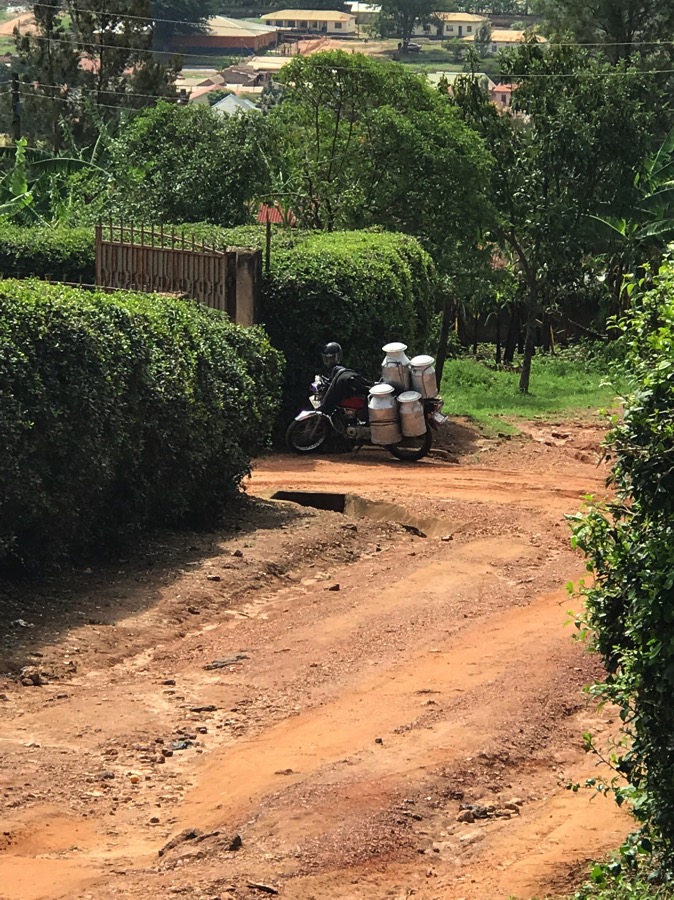
All that being said, getting milk to your house on a weekly basis can prove a challenge. Dairy is regulated here, much the same way meat slaughtering is. There is a Dairy Council. The milk supply is monitored for diseases like listeria. Dairies would get shut down if they sent contaminated milk out in their products.
We still have to be careful that the milk we buy hasn’t been watered down (remember, the water here isn’t potable; you don’t even want to drink it in your milk). Sometimes the local suppliers will skim and dilute their milk to make it go further.
Because of this, we’re cautious where we buy our milk products. Most of the milk for sale in the grocery stores has been treated with UHT (ultra high temperature). Most, if not all, the nutrients have been killed in this process. We could buy from door-to-door milk sellers. Most of these guys probably sell good milk — especially if you get it first thing in the morning, but there is always a danger it’s been diluted with water. The little eduka (shops) that sell milk give you the watered down stuff.
We get ours straight from a dairy farmer outside town. Once a week, Athen goes and gets 10 liters for us in a good old fashioned dairy can.

We strain the milk and refrigerate it. I use it to make all kinds of things. I skim the cream to make butter and buttermilk. I make a gallon of yogurt almost every week. From that, I make cream cheese. If the milk sours (which rarely happens) I make cottage cheese. (We buy our harder cheeses from local vendors or one of the dairies.)
I’m noticing that ice cream is missing from this list! I may have to remedy that in the near future!
Palm Sunday is a huge deal in Uganda. I love this season almost as much as Christmas. Normally, we see family after family walking to church carrying palm branches.
Today, however, as we drove to church, it was pouring rain. Very few people were out in it (they don’t like to go anywhere in the rain). We saw them walking home from church later on, still carrying the palm branches.
We’ve been showing the Jesus film in our churches. We tried to show it at Ngarama last month at their building dedication. We had a tiny bluetooth speaker that couldn’t put out enough sound. No one could hear it above the murmur of voices in the room.
When we went to Kampala last month, one of our stops was Game. Game is a huge store, not much different than Walmart. In fact, Game is owned by Walmart and you can sometimes buy Walmart brands there. We were able to find a more powerful, battery powered, bluetooth speaker.
Last Sunday, we showed the Jesus film at Ngarama again. Not quite everyone returned to see it again, but the people who came wanted to be there. The people listened in rapt attention to the story of Jesus’ life found in the Gospel of Luke. The bigger speaker worked beautifully. Everyone could hear.
People here don’t emote like Americans. Public crying isn’t acceptable. There was uncomfortable laughter at several parts. People cried out when Jesus was beaten and crucified and exclaimed with joy when he rose again. The church women covered their faces so no one would see their tears. One lady got saved after the movie.
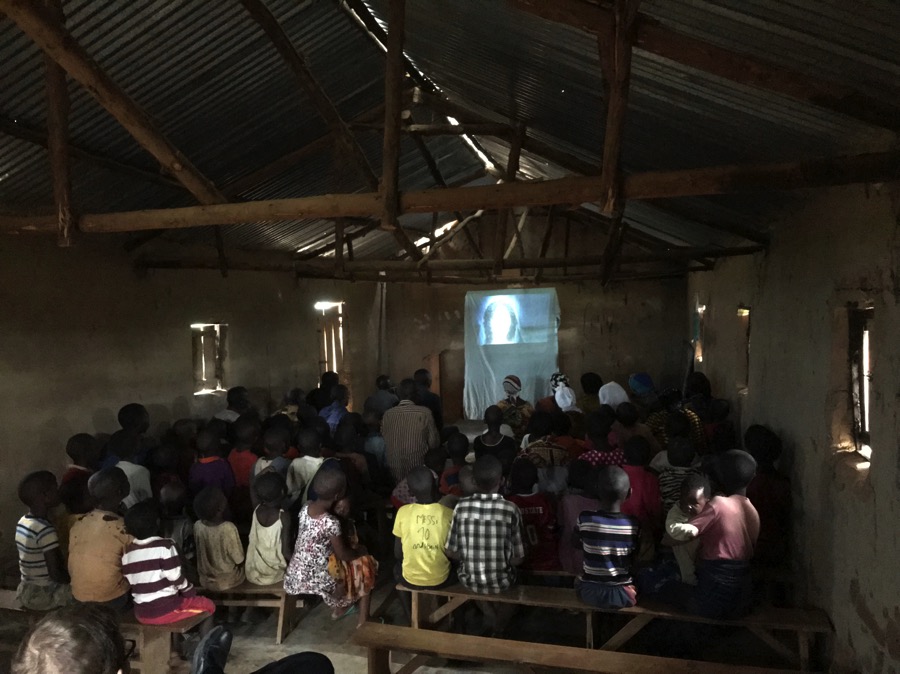
Today we showed the film at Isanja. Due to the rain, very few people were there when we arrived. A few trickled in as we sang. More arrived once the movie started. By the time we finished, the church was packed. We had standing room only. It got hot in there because we had to keep the doors and windows closed so people could see. But no one complained.
Events like this can be tricky at Isanja. Culturally, they are different than any of the other churches. We knew it could get loud there, especially as more and more children came. And boy, were there children! We had at least 80 children packed in amongst the adults. They don’t always listen well and they are easily distracted. They like to come in and out. They talk and cry.

Today, some of the babies cried and cried but the adults were so engrossed in the movie they barely heard them. James ended up with a little girl on his lap and I had to settle two or three tiny ones. One little girl finally fell asleep while I bounced her in my arms.
The people responded much the same as those at Ngarama, but in different places. Even the older children were listening, engrossed. The women in Isanja didn’t try to hide their emotion. They cried out during the crucifixion. Then, when the women in the movie saw that Jesus was risen from the dead, our women threw up their hands and cried “Yesu!” One young boy jumped out of his seat, threw his arms in the air, and shouted.
Next week, on Easter Sunday, we have a joint service for Sangano and Kabazana. We’ll show the movie there and have a short baptism service. I love Easter here. I can hardly wait for it!
I mentioned in my post about our trip to Kampala, how much we love Chinese food. There are three types of food on this earth — Chinese food, Mexican food, and everything else.
I started collecting recipes for our favorite Chinese dishes before we ever had plans to move to Africa. I was thankful I had done this because we discovered the town we live in here has very little variety in food. You can get Central Asian food (Indian), and African food. There are a few places that serve African variations on American dishes that are quite good, but it isn’t the same.
I thought I’d share the recipe for one of my favorite Chinese dishes, Sweet and Sour Chicken (or Pork). It’s fairly simple to make and I’ve adapted it to be easier to fix than if you follow the recipe exactly. I’ll share that below. For now, the recipe as it appears in my book Enjoy Chinese Cuisine, by Judy Lew.
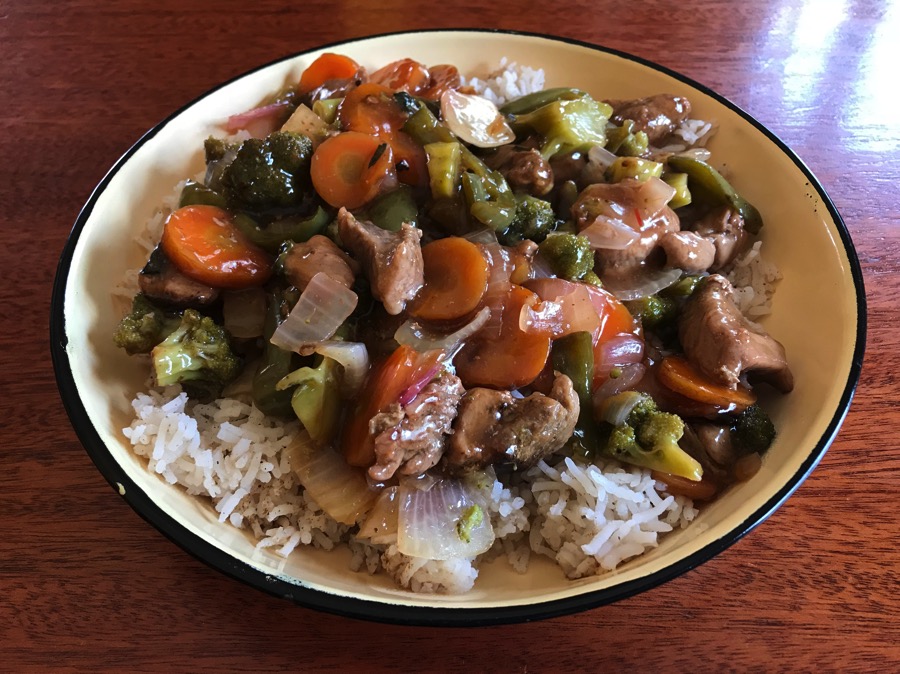
Sweet and Sour Chicken (or Pork)
- 2 Chicken breasts (or 1/2 pound pork cubes
- 1 teaspoon salt (I omit)
- 3 cups oil for deep frying
Batter:
- 1/2 cup flour
- 1/4 cup corn starch
- 1 teaspoon baking powder
- 1/2 teaspoon baking soda
- 3/4 cup cold water
Sweet and Sour Sauce:
- 3/4 cup water
- 2 Tablespoons corn starch
- 2 Tablespoons rice vinegar (I use regular vinegar and it works fine)
- 3 Tablespoons ketchup
- 2/3 cup sugar
Garnish:
- 1 tomato wedged (I omit)
- 1 small green pepper, wedged
- 1/2 cup pineapple chunks
- 1 teaspoon sesame seeds (I omit)
- 1 small onion sliced
- 1 small carrot sliced
Dice the chicken or pork. Mix together the ingredients for the batter. Dredge the chicken or pork pieces through the batter, then fry them in the heated oil until crispy and done (about 4 minutes). Drain onto a paper towel.
Combine sauce ingredients in a small saucepan. Mix together until boiling and thick, stirring constantly.
Arrange chicken and veggie pieces together in a bowl, sprinkle with sesame seeds and pour the sauce over it. Serve with rice.
When I fix it for us, I don’t make the batter or fry the chicken/pork. I sauté the meat until completely cooked, then add the veggies and sauté those until they are tender (add the carrot first, onion last). I don’t usually put pineapple chunks or tomatoes in ours because I don’t like the flavor.
The sauce is good enough to make and keep around for using on other things. I love its flavor! I have to triple the recipe for us but I don’t triple the sugar in the sauce and it still tastes fine.
I hope you try it and enjoy it! Let me know how it turns out!
We’ve entered the rainy season again here. You might remember from my post about the rainy season that we can expect a couple big storms during those months.
Wednesday last week dawned sunny and warm. It was the first truly sunny day we’d had all week so we took advantage of it. The older boys and James helped Athen dig stumps out of the yard while the younger kids and I cleaned house. We hung laundry because it was sunny and the laundry would dry fast.
I needed to go the Wednesday market at Rwebikoona. I’d been putting off a big shop there for weeks, only getting the few little things we needed to get by. James and I went down there and stopped at all our normal places — Elizabet who just had a baby a couple months ago, the lady who sells me beans and teaches me numbers in Runyankore (we got on better this time than last time!), the lady who sells green beans (and gave me double what I thought she was going to!). It was crowded and hot but the sky was clear except for a few high, fluffy clouds.
As we were leaving, I noticed the huge cumulous clouds were forming into cumulonimbus in the distance. We’d been feeling like a storm was brewing all day. Everyone was crabby, even our dogs. I pointed to the clouds and said, “Yep, there’s the storm forming over there!” James agreed with me.
Sure enough, by sunset, storm clouds rolled in. We could see lightning in the distance. A breeze picked up. It didn’t seem that bad.
Then it hit. Sheets of rain came down. It hailed. The rain blew in our windows and doors, even though the doors were shut. We all hurried outside to get pictures. I was able to photograph the lightning.



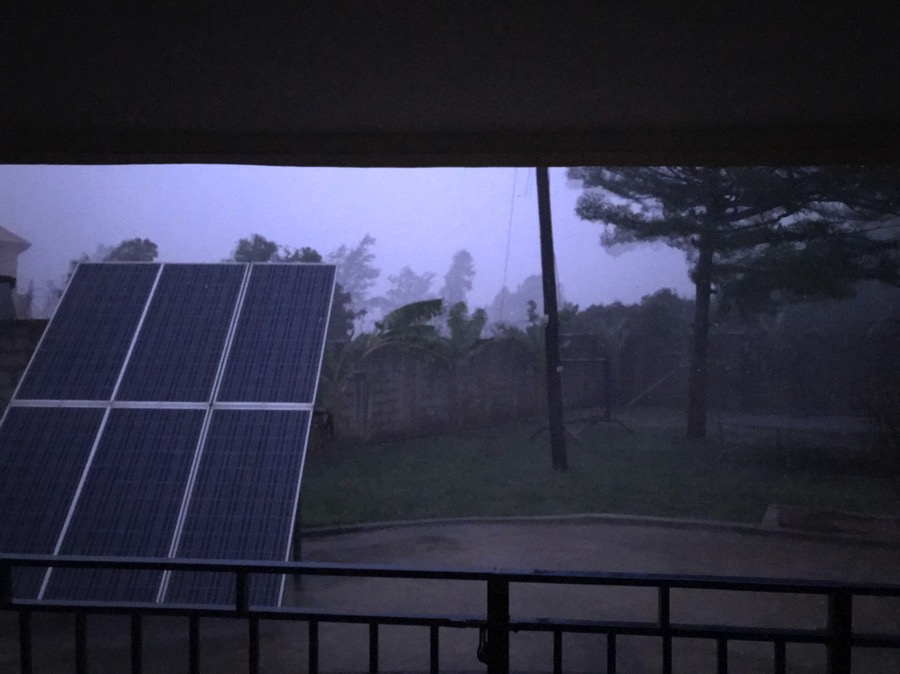
But that wasn’t the worst of it. When the real storm hit, I thought for sure the roof was coming off our house. Power went off. The storm roared its deafening noise above us. We had to yell at each other to be heard. I’ve only seen a couple storms that bad in my life. All the locals I’ve talked to (Athen, our landlady) say they haven’t seen a storm this bad in 20 years.
The worst of the storm had blown over by the time we went to bed. It rained all night and most of the next day.
We were able to see the storm damage the next morning. Many of our banana trees blew over and we had a large crack in our wall. Athen was able to replant the trees and they’re already growing. Power was back on by late morning, which surprised all of us.

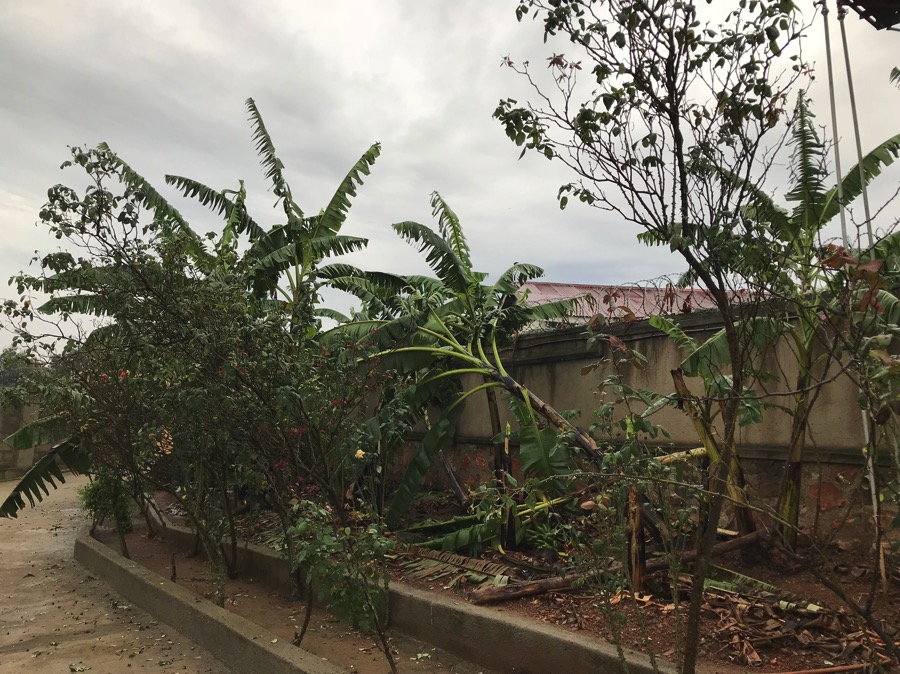

We had it easy. Around the corner from us the entire front of their wall fell into the yard. We’ve seen downed power lines and poles laying in people’s fields. Our neighbor’s field was almost washed away. He’ll have to replant. A power line in another neighbor’s yard keeps shorting. It explodes with a shower of sparks and our power goes off. It’s happened 5 times since Sunday morning and they keep repairing it.
Worst of all, in Rwebikoona, 12 people died in flash flooding. My heart is breaking about this. We were there earlier in the day. At that time of day, the market is usually crowded, people rushing around to get last minute foodstuffs on the way home from work. Then the vendors have to pack up their things and get home. I’m hoping and praying none of my friends were among those who lost their lives.
We all know the old saying, when life gives you puddles, you should run in them. 😉 My youngest daughter decided to take advantage of all the puddles and rain we had on Thursday. She ran around outside in it, screaming and laughing until she was cold and drenched. It brought a spark of joy to the whole situation.
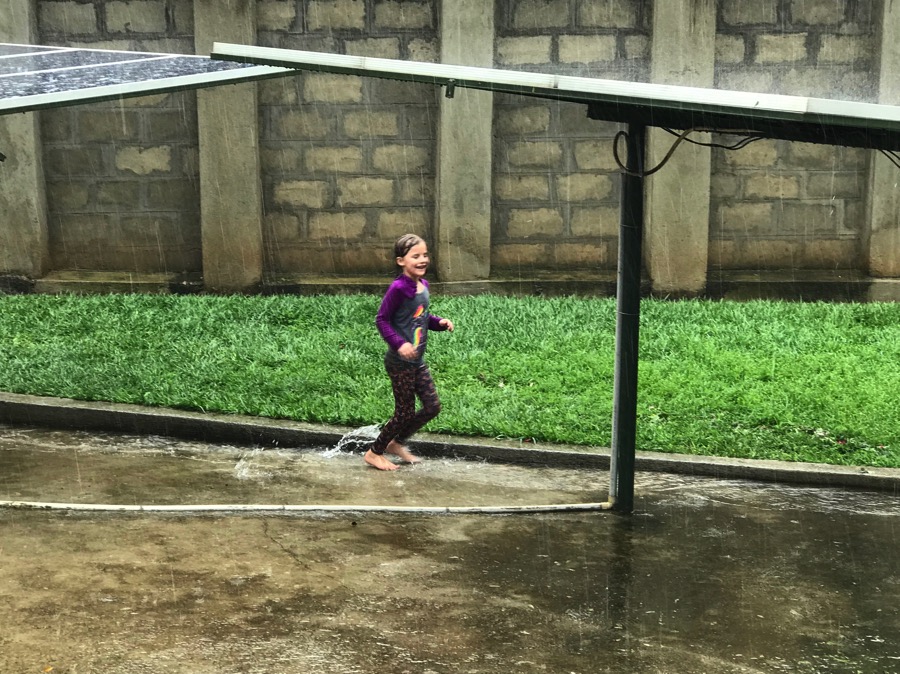
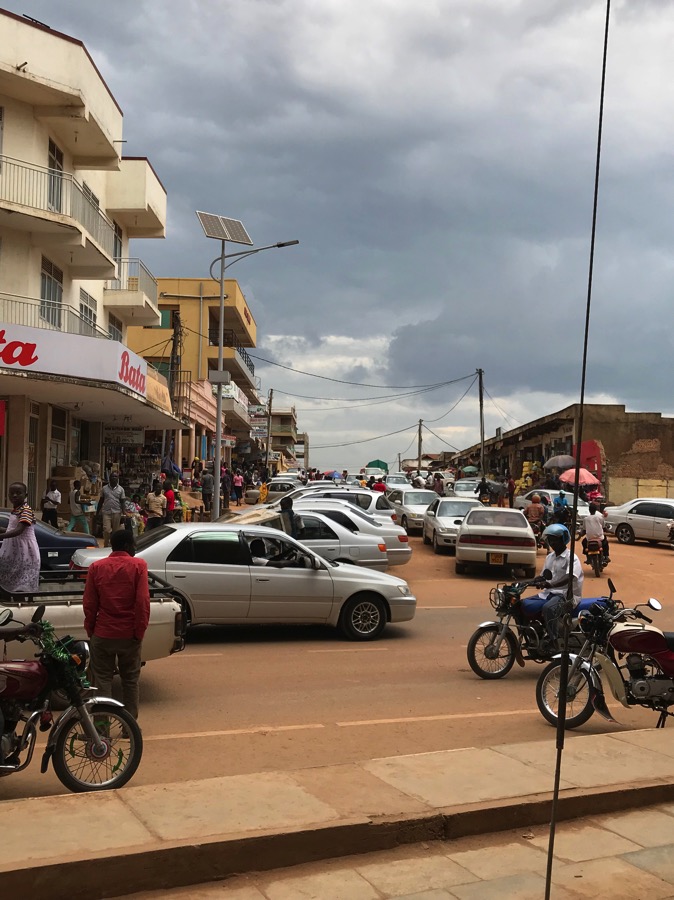
A few days ago James happened across an article that shared a number of things you can’t do in Uganda. The author had followed up a few days later with another list of things he’d missed the first time.
It could be the “can’t do” list is regional, because, as James and I talked, we disagreed with some of them. For instance, bodas frequently park in car parking spots in our town. In fact, they will fill every available parking space and leave no room for other vehicles.
Don’t get me wrong, Uganda is quite the libertarian state — in some respects. In others, you’d better tow the line.
We’ve seen:
- 10+ people crowded into a 4 door sedan that shouldn’t seat more than 5 or 6.
- Women holding their baby on their lap while they ride in the front seat of said sedan.
- Women riding “side saddle” on a boda (motorcycle taxi) with a tiny baby tied on her back, suspended over nothing but air.
- “Scaffolding” next to a 4 story building made of nothing but poles nailed to each other until they are tall enough, with boards balanced on top for the workers to stand on.
- Marijuana growing by the side of the road.
- Huge bonfires started, well, pretty much anywhere something needed to be burned.
- A herd of cows grazing in the local golf course green.
- Any number of livestock kept in and around a person’s property (including but not limited to: cows, goats, sheep, ducks, chickens, and turkeys).
- No permit needed for any modification to property. If you want to change your house or property, hire the workers, buy the supplies, and do it.
- Bars next door to schools and in residential areas. (We had to move houses because a bar opened across the road from us.)
- People, both men and women, urinating by the side of the road.
- Trash – like whole bags of it – thrown out along all the roadways because there are no littering laws or fines.
You don’t need a license to drive a car or motorcycle.
You don’t need a permit to carry a gun if you are a security guard. Once, while on a run, a security guard on a boda went past. The boda driver lost control of his bike and laid it down in the road. The guard, carrying an AK-47, tumbled into the road and the gun fell apart, but didn’t discharge. (Thank God!)
We made our own list, and, while we borrowed from the other one, we included several of our own things in the list.
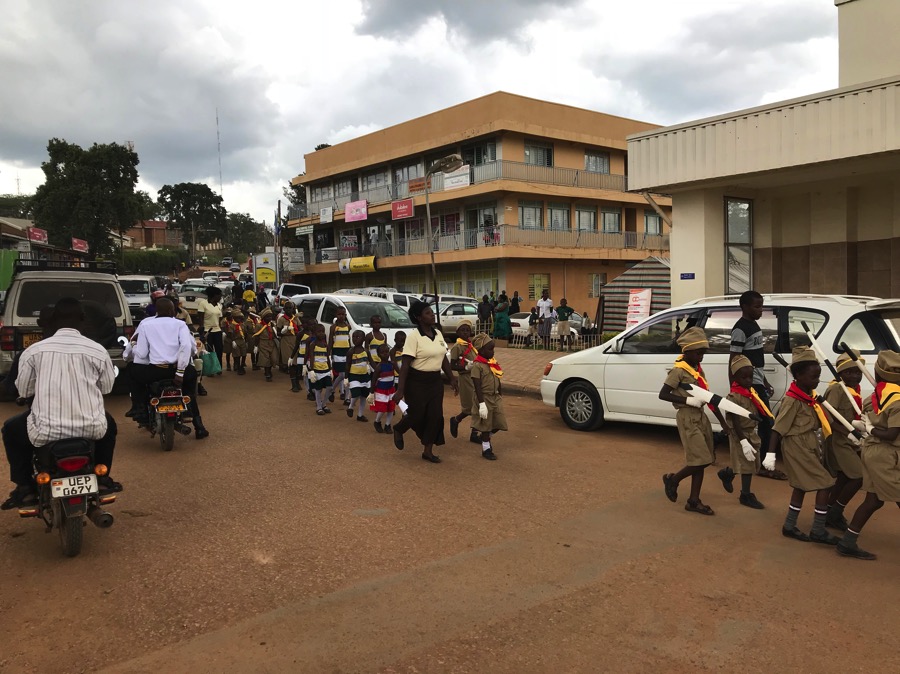
1. Carry things not in a bag
I can’t even tell you the number of times I’ve gotten funny looks because I told the clerk I didn’t want a bag or that I would put the (small) item in my purse. Once, I bought an irregularly shaped, large item. Before giving me my balance, the clerk got up and left, then returned with an overlarge bag into which she struggled to put the item. I stopped her and told her I could carry it out to the car. She gave me a funny look and kept putting it in the bag. I let her. The thing must be put in a bag.
Every now and then, Uganda will ban plastic shopping bags. The ban never sticks. I personally think it’s because people feel they haven’t shopped if they don’t have their item in a bag. (We’ve invested in reusable cloth grocery bags and I use them for almost all my shopping. The shopkeepers in the stores we frequent have learned to expect me to hand them my own bag.)
2. Go anywhere in the rain
No one goes anywhere when it rains in Uganda. I used to think this was weird. Then I tried to go somewhere in the rain. Truth is, when I left home it wasn’t raining. I’d told James I’d meet him in town after he finished an errand in the car. I no sooner reached town than the heavens opened. That’s when I realized why no one goes anywhere in the rain.
First of all, all the bodas in the country must be made of sugar, because their owners park them up on the pedestrian sidewalk under the awnings and out of the rain. Which means none of the pedestrians can walk under the awnings. Which then means that said pedestrian must walk out in the downpour while the boda drivers laugh at them for doing it. Yeah…
Next, the roads turn into a river, making them completely impassible. Dirt roads become slick, muddy swamps and are treacherous to navigate.
We’ve learned not to go anywhere in the rain and not to expect anyone else to, either. The first time someone asked me to go somewhere when it was raining in the US, I was horrified. “But it’s raining!” I said. “Yeah. So?” they replied. “But you don’t go anywhere in the rain!” I caught myself before I said that and realized I’d adapted to at least that part of the culture here in Uganda.
3. Eat or drink while walking
You can’t imagine the looks you’ll get if you carry, say, a travel coffee mug, or a bottle of water (not in a bag) while walking places. People look at you like you have two heads or an extra arm. Why would you ever want something to drink while moving around?
A good friend who used to live here regularly came to my house carrying a mug of coffee with her. We’d laugh together at the funny looks she got.
Drinking (or eating) should be done inside or while sitting. You carry that food or drink with you to your destination in a bag. That’s just the way it is.
4. Be poor and steal
A couple weeks ago, we were at the Wednesday Rwebikoona market shopping for produce. Out of the crowd, we heard cries of “thief! thief!” A knot of people ran toward us. Some of the men carried poles as tall as I am and as thick as my arm, with which they flogged a man in the center of the knot. Others slapped the man, open palmed, and beat him about the head with their fists.
He’d stolen a small beaded purse.
This isn’t the only time we’ve seen this happen. I saw something similar happen in another market and still another time on the road outside our house.
But, while these people were nearly beaten to death for stealing something small, the executives of the local power company stole so much money that the company almost went out of business. Three chain grocery stores have closed here in Uganda because their executives took all the profits and didn’t pay their bills. The telecom in our country is in bankruptcy for the same reason.
Where are these rich thieves? Living it up with their stolen goods in another country.
So, the only time thievery matters is if you are poor and get caught doing it.
5. Talk about money
Ugandans don’t talk about money. They will hedge on the price of things or make their way around asking for fair wages. They will employ any and all methods of diversion to avoid stating an amount. A Ugandan will blush, refuse to meet your eye, and sometimes get up and leave rather than coming out and stating what they want. As an American of German heritage, this feels like deception to me. I feel like they are trying to fleece me out of money. I prefer open, honest negotiation and I’m pretty good at it, too.
We’ve managed to learn ways to talk about money with people like employees and our landlord. Marketing is easier because the vendors want your money. But if you’re buying a large item from a shop in town, the shopkeeper will try to make the hard sell before telling you the price. The best way to respond when they inform you of the doubled price and try to make it sound like a bargain is to laugh. Hard. And walk away. They usually come down to something more reasonable once they figure out you aren’t a newbie to the whole negotiation process.
6. Wear ugly shoes
I love shoes. I’m the first to admit it. But I also like practical shoes, shoes appropriate for the situation. Before we came to Uganda, I got a nice pair of hiking shoes, thinking they’d be perfect for navigating the rough dirt roads common to our area. One day, it had rained all morning and I needed to go to town that afternoon. The roads were still muddy so I decided to wear my hiking shoes.
I kid you not, total strangers stopped me to tell me I should not have worn those shoes. More than one of them.
I didn’t wear them to town again, but one day decided to wear them to the market, again after a rain. Again, total strangers told me I shouldn’t have worn the shoes.
I’ve managed to find a happy medium. I try to find shoes with cute tops and sturdy soles. No more comments from strangers.
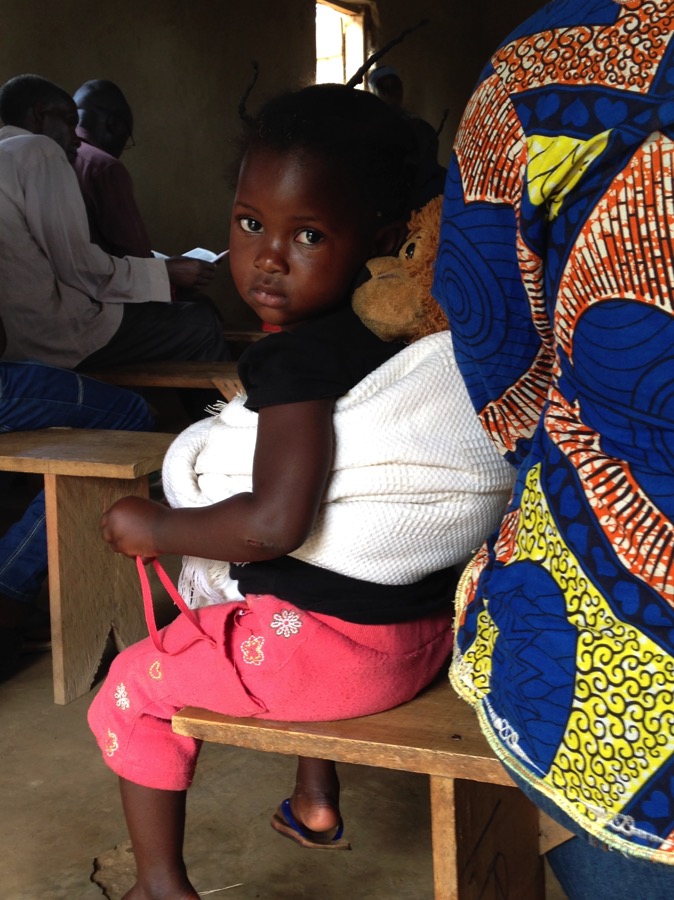
7. Carry a baby in a carrier on the front of your body
The women here wear their babies tied to their backs. Even tiny girls learn how to carry siblings this way. I’ve always thought it looked uncomfortable. I invested in a sling carrier for my youngest baby, born here about a year after we arrived. Every time I carried her to town that way, someone stopped me and told me I was breaking her back and that I shouldn’t do it that way.
(They also frequently told me when she was hungry, and that she was cold because she only had on a jacket, not layer upon layer of warm clothing and thick blankets.)
8. Be Gay
Uganda has some of the strictest laws against homosexuality that I’ve ever heard of anywhere. I’m thankful for the stand that this country has taken, even against other countries trying to force them to change.
That said, this law can come across as hypocritical. Prostitution, fornication, and adultery are rampant. Girls are not allowed to say “no” to men who demand sexual favors. Men, even supposed men of God, have “side dishes,” or women with whom they commit adultery. Women, even church women, will earn extra money on the side by gratifying men. The only time it ever becomes a problem is if the offenders are caught in the act.
In their defense, the government has done a widespread abstinence campaign. I’m not sure how well it has worked thus far, though they are reporting their AIDS cases having decreased significantly in the last few years.
9. Confront anyone about anything
Ugandans do NOT like confrontation. If you want to confront a Ugandan about anything, you have to talk to other people first and hope the problem gets back to them so they know you have a problem. If you force them to sit down and talk about the problem, they will talk about a multitude of other problems they have first before talking about the issue at hand. It makes dealing with interpersonal relationship conflicts both challenging and time consuming and sometimes you don’t even know if the problem was solved.
When confronted, they will sulk, deny the problem, avoid eye contact, change the subject, accuse someone else of something to deflect the focus off the problem at hand. Worst case, they will get up and leave in anger.
Americans, especially Christians, generally don’t deal with things this way. We face problems head on. We prefer to go to the person with whom we have a problem and talk to them directly. This preference does not play nice with the general culture here on problem solving and interpersonal relationship conflict.
I’m sure there are things I’m missing here, too. Maybe I’ll have to revisit this issue at some point in the future. But I hope this gives you another small glimpse into life here. If there is something you want to know, feel free to leave a comment or contact me with the question and I’d be happy to try to answer!
We pass a Mosque on Masaka Road on the way to Kampala. It’s a fairly new building, built since we arrived in Uganda. But they skimped a little on construction.
The result is that 5 times a day, a man has to climb the ladder seen in this picture to deliver the Muslim prayer call. Two of those times are in the dark.
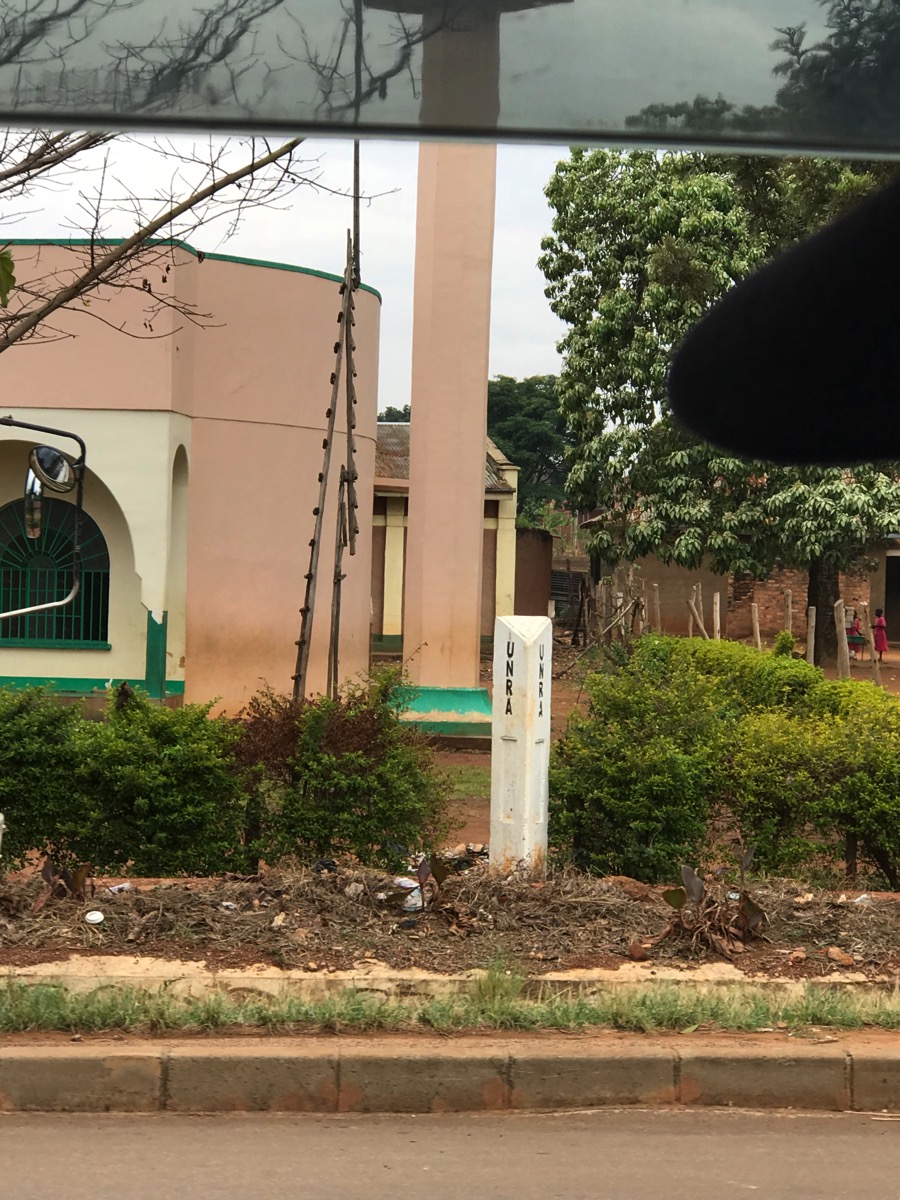
I’m pretty sure this is either a great act of (misplaced) faith or another reason that women live longer than men. You can decide which it is.
(Sorry for the wonky picture. I took it while we were driving and a hundredth of a second before a truck came by the other way and blocked my shot. It isn’t well centered and you get too much road and car portions and the bill of James’ ball cap. If you look at the very top of the picture, you can see the platform onto which the man climbs when he delivers the prayer call.)
